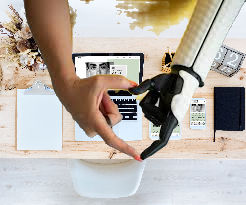Inclusive Research, by design
- Alicia Jarvis
- Aug 26, 2021
- 2 min read
Updated: Nov 5, 2025

When I was much younger, doctors told me I couldn’t have prosthetics because I had hands and they had never seen someone like me wear prosthetics. So, with some help from my good friends at the War Amps, I did some research and found a picture of two identical twins from Germany who just like me had short arms and were fitted with prosthetic arms. The key message here is access to information is a powerful thing; so, don’t skip your desk research. There are communities full of knowledge and information out there if you just look for them.
It is a researcher’s job to ask the hard questions. In order to have an inclusive research practice, you have to first acknowledge and recognize exclusion, in all its forms. To quote Kat Holmes, “Designing for inclusion starts with recognizing exclusion.” People are not boxes and labels are for food, not people. One person’s experience is exactly that; one person’s experience. Don’t expect one person to represent an entire race or group of people. Yes, I have a disability and I’m a woman, but I cannot and will not speak for or on behalf of all women with disabilities. I can only speak from my own experiences. So, instead, what you want to do is continuously ask who is not here, why aren’t they here, and what can we as designers and researchers do about it.
You can immediately start making your research practice more inclusive by actively engaging diverse communities and involving everyone and I mean everyone! Be intentional about how you conduct research, and with whom.
Encourage broad participation in research activities by:
Using inclusive language in recruitment and research materials.
Actively seeking out design input from people who don’t look like you, or sound like you.
Interviewing individuals who represent a wide range of human diversity to understand their context and methods of accessing technology.
Asking questions that consider outliers or alternate points of view.
Synthesizing and implementing interview insights and user considerations into every project.
Testing content, prototypes, and visuals with people who have varying abilities or use different access methods
Implementing changes based on research findings and user feedback.



Comments